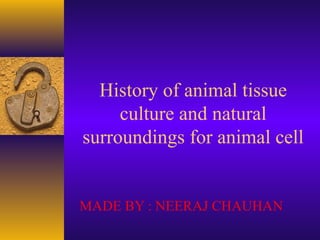History of animal tissue culture and natural surroundings for animal cell
•Download as PPT, PDF•
26 likes•14,627 views
This document discusses the history of animal tissue culture and factors that affect culturing animal cells. It notes that Roux in 1885 was the first to culture embryonic chick cells and Harrison in 1907 successfully cultured nerve cells. Key events over 130 years included development of defined media and serum-free media. Factors that impact cell culture choice include cell yield, whether cells are monolayer or suspension, venting, sampling needs, growth uniformity, and cost. Environmental factors like pH, temperature, gas phase, osmolarity, foaming, and viscosity must also be controlled to maintain optimal cell growth conditions.
Report
Share
Report
Share

Recommended
Recommended
More Related Content
What's hot
What's hot (20)
Role of serum and supplements in culture medium k.s

Role of serum and supplements in culture medium k.s
Constituent of animal tissue culture media and their specific application

Constituent of animal tissue culture media and their specific application
Types of animal cell culture; characterization & Their preservation.

Types of animal cell culture; characterization & Their preservation.
Animal cell culture & its technique & cyropreservation: A review

Animal cell culture & its technique & cyropreservation: A review
Similar to History of animal tissue culture and natural surroundings for animal cell
Similar to History of animal tissue culture and natural surroundings for animal cell (20)
Historyofanimalcellculturecellfinal 120928123709-phpapp01

Historyofanimalcellculturecellfinal 120928123709-phpapp01
the fundemental facts about the culturing of animal cells.ppt

the fundemental facts about the culturing of animal cells.ppt
Lecture 28_ Cultivation of Bacteria (Growth of bacteria).ppt

Lecture 28_ Cultivation of Bacteria (Growth of bacteria).ppt
Animal tissue culture-BIOTECH -Copperbelt University,kitwe-Zambia

Animal tissue culture-BIOTECH -Copperbelt University,kitwe-Zambia
presentation_plant_tissue_culture_and_applications_1458709606_158882.ppt

presentation_plant_tissue_culture_and_applications_1458709606_158882.ppt
presentation_plant_tissue_culture_and_applications_1458709606_158882.ppt

presentation_plant_tissue_culture_and_applications_1458709606_158882.ppt
History of animal tissue culture and natural surroundings for animal cell
- 1. History of animal tissue culture and natural surroundings for animal cell MADE BY : NEERAJ CHAUHAN
- 2. Introduction of ATC • Animal Tissue Culture ? • Roux in 1885 for the first time maintained embryonic chick cells in a cell culture • Cell culture was first successfully undertaken by Ross Harrison in 1907.
- 4. Historical events in the development of cell culture • 130-140 years old. • Arnold (1880) –showed that leucocytes can divide outside body. • Roux (1885)- maintained embryonic chick cells in a saline culture. • Jolly (1903)- studied behaviours of animal cells immersed in serum lymph . • Ross Harrison (1907)- cultivated frog nerve cells in a lymph clot and observed the growth of nerve fibers in vitro.
- 5. • Lewis (1911) - made the first liquid media consisted of sea water, serum, embryo extract, salts and peptones. • Carrel (1913) - developed a method for maintaining cultures free from contamination. • Rous and Jones (1916) – trypsinization and subculture of explants. • Eagle (1955) – development of defined media. • Littlefield (1964) - introduced the HAT medium for cell selection. • Ham (1965) - introduced the first serum-free medium which was able to support the growth of some cells.
- 6. • Harris and Watkins (1965) - were able to fuse human and mouse cells by the use of a virus.
- 8. Factors which effect the choice choice of the substrate 1. Cell yield (cell production) – • For small scale production we use micro titration plates multi well plates. Micro titration plate
- 9. Multi well plates • For large scale production we use flask and petri dishes
- 10. 2.Whether the cells are monolayer/suspension culture - • Monolayer culture Microtitration plate • Suspension culture Flask 3.Venting – Airing to culture. • Also called as aeration. 4.Sampling and Analysis – • Micro wells are used for sampling. • Two type of microscopes are used for analysis.
- 11. Inverted microscope Phase contrast microscope 5.Uneven Growth - When r.p.m. is high during shaking than uneven growth comes. 6.Cost
- 13. 1. pH- potential of H+ ion . Optimum pH Animal tissue – 7.4 Plant tissue – 5.5 Epidermal tissue – 5.5 Transformed tissue – 7-7.4 Fibroblast - 7.4- 7.7 2. Temperature – Optimum temperature Animal – 37 ͦ C Birds – 38.5 ͦ C
- 14. 3. Gas Phase – Two phase CO2 - drops pH level • 5% required by the cells. O2 – 40-90% required • Some cells requires more O2 ,than extra O2 carrier sources added i.e Hb . 4.Osmolarity – Salt concentration of the cell Animal - 290miliosmo /kg Mice - 310milliosmo /kg 5.Foaming – Characteristic of suspension. Drawbacks :- contamination occure. • Denaturation of protein.
- 15. • Interfare with the exchange of gas phase . • To prevent foaming add antifoaming agent ex :- Pluronic F68,CMC( carboxy methyl cellulose) 6.Viscosity – Serum is added to increase viscosity.
- 16. Thanks
